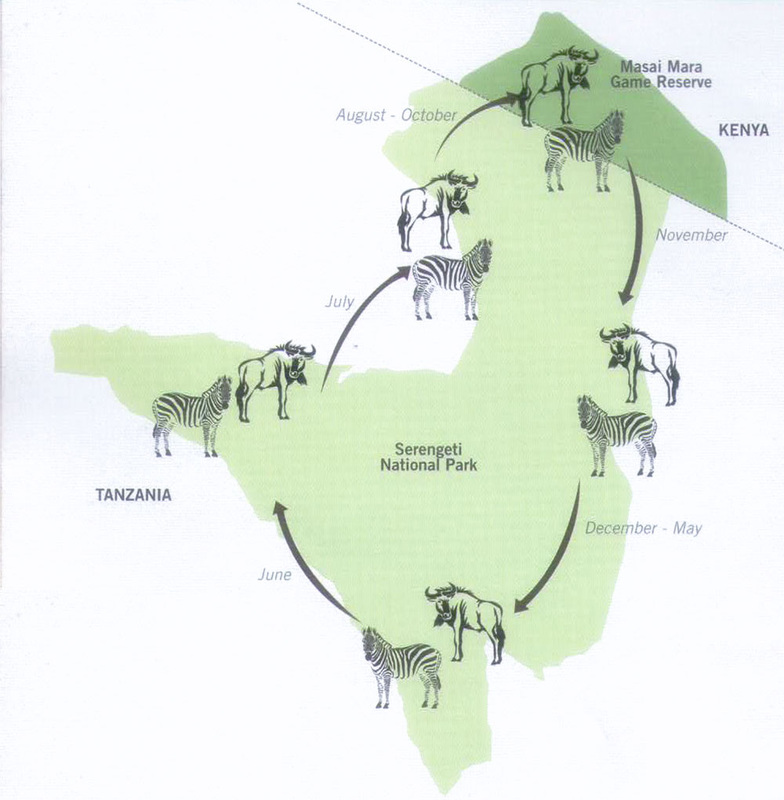"The Wildebeest Migration"
One of the great natural wonders of the world is the migration of wildebeest and zebra that takes place in Northern Tanzania and Southern Kenya every year. You can see this spectacle at various stages but timing is everything. You need to select the timing and location of your safari carefully to ensure you do see what you came for. Tourist numbers are at a peak during the phase when it crosses into the Masai Mara, so booking well in advance is essential as accommodation in the region is limited.
Here is the migration cycle and its timing:
Each year around the same time, the circular great wildebeest migration begins in the Ngorongoro Conservation Area of the southern Serengeti in Tanzania. This migration is a natural phenomenon determined by the availability of grazing. This phase lasts from approximately January to March, when the calving season begins – a time when there is plenty of rain-ripened grass available for the 260,000 zebra that precede 1.7 million wildebeest and the following hundreds of thousands of other plains game.
During February, the wildebeest spend their time on the short grass plains of the southeastern part of the ecosystem, grazing and giving birth to approximately 500,000 calves within a 2 to 3-week period. Few calves are born ahead of time and of these, hardly any survive. The main reason is that very young calves are more noticeable to predators when mixed with older calves from the previous year. As the rains end in May, the animals start moving northwest into the areas around the Grumeti River, where they typically remain until late June. The crossings of the Grumeti and Mara rivers beginning in July are a popular safari attraction because crocodiles are lying in wait. The herds arrive in Kenya in late July / August, where they stay for the remainder of the dry season.
In early November with the start of the short rains, the migration starts moving south again, to the short grass plains of the southeast, usually arriving in December in plenty of time for calving in January-February.
One of the great natural wonders of the world is the migration of wildebeest and zebra that takes place in Northern Tanzania and Southern Kenya every year. You can see this spectacle at various stages but timing is everything. You need to select the timing and location of your safari carefully to ensure you do see what you came for. Tourist numbers are at a peak during the phase when it crosses into the Masai Mara, so booking well in advance is essential as accommodation in the region is limited.
Here is the migration cycle and its timing:
Each year around the same time, the circular great wildebeest migration begins in the Ngorongoro Conservation Area of the southern Serengeti in Tanzania. This migration is a natural phenomenon determined by the availability of grazing. This phase lasts from approximately January to March, when the calving season begins – a time when there is plenty of rain-ripened grass available for the 260,000 zebra that precede 1.7 million wildebeest and the following hundreds of thousands of other plains game.
During February, the wildebeest spend their time on the short grass plains of the southeastern part of the ecosystem, grazing and giving birth to approximately 500,000 calves within a 2 to 3-week period. Few calves are born ahead of time and of these, hardly any survive. The main reason is that very young calves are more noticeable to predators when mixed with older calves from the previous year. As the rains end in May, the animals start moving northwest into the areas around the Grumeti River, where they typically remain until late June. The crossings of the Grumeti and Mara rivers beginning in July are a popular safari attraction because crocodiles are lying in wait. The herds arrive in Kenya in late July / August, where they stay for the remainder of the dry season.
In early November with the start of the short rains, the migration starts moving south again, to the short grass plains of the southeast, usually arriving in December in plenty of time for calving in January-February.








